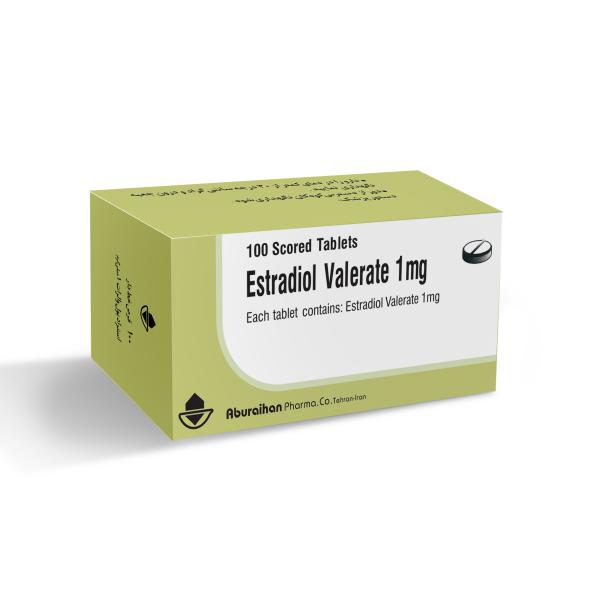Estradiol valerate
Estradiol valerate
1 & 2 mg film-coated tablet, 10 mg ampoule
- Treatment of moderate to severe vasomotor symptoms associated with the menopause.
- Treatment of moderate to severe symptoms of vulvar and vaginal atrophy associated with the menopause. When prescribing solely for the treatment of symptoms of vulvar and vaginal atrophy, topical vaginal products should be considered.
- Treatment of hypoestrogenism due to hypogonadism, castration or primary ovarian failure.
- Treatment of advanced androgen-dependent carcinoma of the prostate (for palliation only).
Mechanism of Action:
Estradiol is the principle intracellular human estrogen, Estrogens modulate the pituitary secretion of gonadotropins, luteinizing hormone, and follicle-stimulating hormone through a negative feedback system; estrogen replacement reduces elevated levels of these hormones in postmenopausal women.
Method of Administration:
Breast cancer, metastatic:
Oral: Males and postmenopausal females: 10 mg 3 times/day or (off-label dosing) postmenopausal women: 2 mg 3 times/day
Hormone therapy for transgender females (male-to-female), monotherapy or combination
therapy (off-label use):
IM: 5 to 30 mg every 2 weeks.
Oral: 2 to 6 mg/day.
Note: Adjust dose with a goal of elevating serum estradiol levels and suppressing serum testosterone
levels into the normal range for females.
Hypoestrogenism (female) due to hypogonadism, castration, or primary ovarian failure:
Oral: 1 to 2 mg/day; titrate as necessary to control symptoms using minimal effective dose for maintenance therapy.
IM: 10 to 20 mg every 4 weeks.
Hypoestrogenism (female) due to hypogonadism:
IM: 1.5 to 2 mg monthly.
Osteoporosis prevention (females):
Oral: Lowest effective dose has not been determined; doses of at least 0.5 mg/day were used in clinical studies evaluating bone mineral density.
Prostate cancer, advanced:
IM: 30 mg or more every 1 to 2 weeks.
Oral: 1 to 2 mg 3 times/day.
Vasomotor symptoms (moderate to severe) associated with menopause:
Oral: 0.5 to 1 mg once daily. Dosage range: 0.5 to 2 mg/day
IM: 10 to 20 mg every 4 weeks.
Vulvar and vaginal atrophy (moderate to severe) associated with menopause:
IM: 10 to 20 mg every 4 weeks.
Oral: 0.5 to 1 mg/day
Notes
Contraindications:
Angioedema, anaphylactic reaction, or hypersensitivity to estradiol or any component of the formulation; undiagnosed abnormal genital bleeding; DVT or PE (current or history of); active or history of arterial thromboembolic disease (eg, stroke, MI); breast cancer (known, suspected or history of), except in appropriately selected patients being treated for metastatic disease; estrogen-dependent tumor (known or suspected); hepatic impairment or disease; known protein C, protein S, antithrombin deficiency or other known thrombophilic disorders.
Interactions:
Antidiabetic Agents: Hyperglycemia-Associated Agents may diminish the therapeutic effect of Antidiabetic Agents. Risk C: Monitor therapy
CYP3A4 Inducers (Moderate): May decrease the serum concentration of Estrogen Derivatives. Risk C:
Monitor therapy
CYP3A4 Inducers (Strong): May decrease the serum concentration of Estrogen Derivatives. Risk C:
Monitor therapy
CYP3A4 Inhibitors (Strong): May increase the serum concentration of Estrogen Derivatives. Risk C:
Monitor therapy
TiZANidine: CYP1A2 Inhibitors (Weak) may increase the serum concentration of TiZANidine. Management: Avoid these combinations when possible. If combined use is necessary, initiate tizanidine at an adult dose of 2 mg and increase in 2 to 4 mg increments based on patient response. Monitor for increased effects of tizanidine, including adverse reactions. Risk D: Consider therapy modification
Pregnancy and Lactation:
Products approved for use only in postmenopausal patients are not appropriate for use during pregnancy.
Estrogens are present in breast milk. The decision to breastfeed during therapy should consider the risk of infant exposure, the benefits of breastfeeding to the infant, and the benefits of treatment to the mother. Monitor the growth of the infant closely.
Warning and Precaution:
- Anaphylaxis: Anaphylaxis requiring emergency medical management has been reported and may
develop at any time during therapy. Angioedema involving the face, feet, hands, larynx, and tongue
has also been reported.
- Breast cancer: [US Boxed Warning]: Based on data from the Women’s Health Initiative (WHI)
studies, an increased risk of invasive breast cancer was observed in postmenopausal women using conjugated estrogens (CE) in combination with medroxyprogesterone acetate (MPA).
- Dementia: [US Boxed Warning]: Do not use estrogens with or without progestin to prevent
dementia. In the Women’s Health Initiative Memory Study (WHIMS), an increased incidence
of probable dementia was observed in women ≥65 years of age taking CE alone or in
combination with MPA.
- Endometrial cancer: [US Boxed Warning]: The use of unopposed estrogen in women with a uterus is associated with an increased risk of endometrial cancer. The addition of a progestin to estrogen therapy may decrease the risk of endometrial hyperplasia, a precursor to endometrial cancer. Use adequate diagnostic measures, including endometrial sampling if indicated, to rule out malignancy in postmenopausal women with undiagnosed abnormal vaginal bleeding.
- Endometriosis: Estrogens may exacerbate endometriosis. Malignant transformation of residual endometrial implants has been reported posthysterectomy with unopposed estrogen therapy.
- Lipid effects: Estrogen compounds are generally associated with lipid effects such as increased HDLcholesterol and decreased LDL-cholesterol. Triglycerides may also be increased in women with preexisting hypertriglyceridemia; discontinue if pancreatitis occurs.
Adverse Reactions:
Abdominal pain, breast tenderness, endometrium disease, leukorrhea, headache, Acne vulgaris, genital pruritus
Storage:
Store below 30 and protect from light and moisture.


